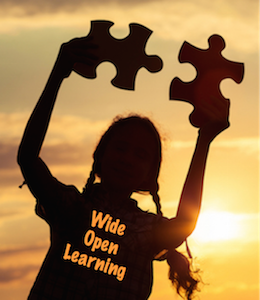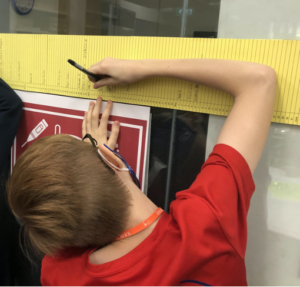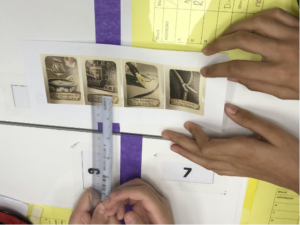Visualizing History Using Timeline Tools
A MiddleWeb Blog
 Creating timelines is one of the first activities we do in our sixth grade social studies classes.
Creating timelines is one of the first activities we do in our sixth grade social studies classes.
We want students to visualize the relationships between historical events and be able to think chronologically about time periods.
One of the best ways to engage sixth graders in “timeline thinking” is to make the lesson personal.
This year, as students entered my classroom, they added their birthday to our grade’s timeline, which stretches along the wall. This led to the creation of their own personal timelines, a classic social studies activity.

A student adds his birthday to the grade’s timeline.
We did this activity on long pieces of paper (let’s decorate that classroom!), but there are many free online sites you could use, like Timetoast or Preceden.
Students who finished early decided to independently create timelines on topics like the history of Manchester United and the plot running through the Harry Potter series.
We always welcome any opportunity for interdisciplinary connections, so English teachers could ask students to consider their reading history timelines. These topics could look like “the first time I read a book by myself” or “the first movie I saw that was based on a book I read,” and could then be added to the students’ personal timelines.
I’m always looking for ways to incorporate memes in the classroom because students love them, and when done right, they demonstrate a high level of understanding of the content. At the end of an intensive study of an era, students could create a timeline and include a meme (original or one that they found) that helps explain the event.
Timeline Prep
If you have access to Flocabulary, it has an excellent video that explains how timelines work and different terms for time periods. Don’t have Flocabulary in your class?
Watch a video about timelines from Clarendon Learning (above) with your class and challenge them to write a song or poem that teaches about the elements of a timeline.
More Timeline Activities
A new favorite card game in our class is Timeline, where each card features a historical event on one side and the date on the back.

Students discuss options during a game of Timeline.
There are many suggested ways to play the game, but COVID-19 restrictions and the tiny size of the cards had me taking photos of four cards together and displaying them on a slide for the class, who worked in small groups to create a timeline for the events displayed.
I encouraged students to explain the logic behind their choices before I revealed the correct chronological order. Students loved this activity, and it is one I will continue throughout the year.
Another activity is creating timelines using manipulatives. Play-Doh can be used, but I prefer Legos; they are easy to clean and have a longer shelf life. Students can read a brief passage that includes different events and then create a tactile timeline to show their understanding.
I like that this activity requires an explanation. If students work in pairs, the conversation as they break down the passage further cements their grasp of the text. If you want to go big, have students work together with colored painter’s tape and have them create a timeline on the floor or outside.
If you want to add movement to your study of timelines, you can post descriptions of events around the classroom, then have the students retrieve them and figure out where they fit on a timeline with the dates already included. This could be done as a pre-reading activity, then repeated afterwards to demonstrate their understanding.
How Do You Use Timelines?
I’ve switched from teaching English to teaching social studies this year, and I am so excited by all the possibilities to infuse my lessons with games, activities to build literacy, and real world connections. If you have any suggestions about other fun ways to teach timelines, please add your ideas to the comments below.





























Great ideas, thanks, Megan!!